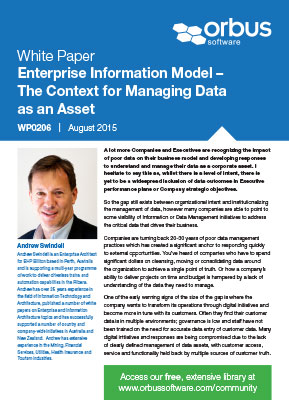A lot more Companies and Executives are recognizing the impact of poor data on their business model and developing responses to understand and manage their data as a corporate asset. Whilst there is a level of intent, there is yet to be a widespread inclusion of data outcomes in Executive performance plans or Company strategic objectives - the gap still exists between organizational intent and institutionalizing the management of data. In situations of organizational data inertia, the Enterprise Information Model (EIM) is a simple method that can be used to visualize and represent the pain that is preventing the company from achieving its objectives. Andrew Swindell’s new white paper explores the development and use of the EIM to support strategic outcomes and how it can engage stakeholders at all levels.
A lot more Companies and Executives are recognizing the impact of poor data on their business model and developing responses to understand and manage their data as a corporate asset. I hesitate to say this as, whilst there is a level of intent, there is yet to be a widespread inclusion of data outcomes in Executive performance plans or Company strategic objectives.
So the gap still exists between organizational intent and institutionalizing the management of data, however many companies are able to point to some visibility of Information or Data Management initiatives to address the critical data that drives their business.
Companies are turning back 20-30 years of poor data management practices which has created a significant anchor to responding quickly to external opportunities. You’ve heard of companies who have to spend significant dollars on cleansing, moving or consolidating data around the organization to achieve a single point of truth. Or how a company’s ability to deliver projects on time and budget is hampered by a lack of understanding of the data they need to manage.
One of the early warning signs of the size of the gap is where the company wants to transform its operations through digital initiatives and become more in tune with its customers. Often they find their customer data is in multiple environments; governance is low and staff have not been trained on the need for accurate data entry of customer data. Many digital initiatives and responses are being compromised due to the lack of clearly defined management of data assets, with customer access, service and functionality held back by multiple sources of customer truth.
Login to continue reading or register now to download the ebook.
